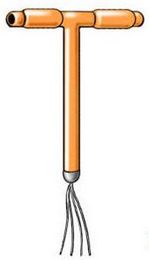Spiral intrauterine – removal – Removing the Navy
Description IUD removal
Intrauterine device (Navy) is one method of contraception for women. Gormonosoderzhaschaya IUD can also be used for other purposes. The spiral is inserted through the vagina the uterus doctor. During pregnancy, the fetus is in the uterus.
Women with established IUD may need to uninstall it. Removing the Navy made a doctor. You should never remove the IUD yourself.

Reasons for removal of the IUD
There are two types of IUDs:
- Gormonosoderzhaschaya Navy;
- Copper IUD.
Gormonosoderzhaschaya IUDs can remain in the body for five. Copper IUDs can remain for 10 years. After this period the IUD should be removed or replaced.
Other reasons to remove the IUD may include:
- Of infection, sexually transmitted;
- Side effects (eg, bleeding, pain);
- Heavy and / or prolonged menstrual bleeding;
- Pregnancy, despite the presence of an intrauterine device;
- Do you want to use another method of contraception;
- Do you want to get pregnant;
- Menses ended due to menopause;
- You need treatment, which requires the removal of the IUD.
Possible complications of removing the intrauterine device
Serious complications are rare, but no procedure does not guarantee the absence of risk. If you plan to IUD removal, You need to know, that may arise during the removal and bleeding convulsions, but it is normal. Some women may faint or experience lightheadedness immediately after the procedure.
IUDs can be removed at any time, but it is better to do it during menstruation, as the cervix during this period softer. After, as the Navy removed, a woman can become pregnant again.
If the IUD is removed in the middle of the menstrual cycle, and you had sex during the week before removal, it is likely to get pregnant.
How is the removal of an intrauterine device?
Preparation for the procedure
Before removing the IUD need to ask your doctor questions to, concerning the procedure. It is necessary to define, what type of contraception you wish to use in the future, if you do not want to get pregnant. Sometimes you may need to start using another method of contraception before removing the IUD.
Anesthesia
In most cases, anesthesia is not used. Your doctor may prescribe pain medicine or numb the cervix, to ease the discomfort during the removal.
Procedure IUD removal
This procedure is usually performed in an outpatient setting without the need to stay in hospital.
First, the doctor inserts a speculum into the vagina, to see the cervix. The cervix and vagina will be treated with an antiseptic., such as iodine. Then the doctor finds a thread Navy (” mustache”). The yarns are typically visible from the cervix into the vagina. The doctor will ask you to take a deep, slow breath. During the procedure you need to relax. The doctor will use forceps or other tools, to grab the thread and gently pull the IUD.
If necessary, after the removal of the place of the old set a new IUD.
There may be situations, when IUDs are difficult to remove. In these cases, your doctor may refer you to another specialist. There is a possibility, that IUD removal, perhaps, need hysteroscopy. Hysteroscope – it's a long, a thin tube with a camera and surgical instruments at the end of. It is inserted into the vagina and uterus, to locate and remove the IUD.
How long will the removal of intrauterine device?
The procedure takes only a few minutes.
Removal of an intrauterine device – Will it hurt?
You may experience cramping and bleeding during removal of the helix. This is a normal situation.
Care after the removal of an intrauterine device
Be sure to follow your doctor's instructions, when you return home after the procedure. If you start using another method of contraception, make sure, it would be safe for you.
If you are going to get pregnant, you need to start taking prenatal vitamins.
Contact your doctor after udaleniyavnutrimatochnoy spiral
After returning home, you need to see a doctor, If the following symptoms:
- Severe cramps, pain or tenderness in the abdomen;
- Fever or chills;
- Unexplained vaginal bleeding or vaginal discharge.
